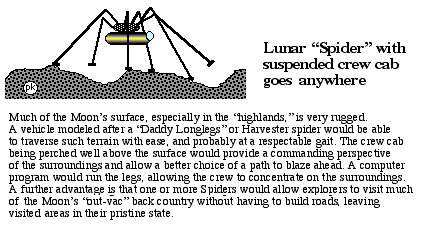MMM Glossary - "MMM Speak" New Words & Old Words with New Meanings
This Glossary has been a much-interrupted "work in progress"
Introduced May 18, 2009
Transferred from Lunar Reclamation Society website to Moon Society site March 11, 2010
300+ entries and many more to come
Updated September 16, 2010
ForewordWhy a Glossary For Moon Miners' Manifesto?
From the very beginning, we got some criticism for coining new words, giving some old words new meaning. "Readers will be confused.! But we reject this criticism. Every frontier-settling experience has brought with it many new words and meanings. This is inevitable, as every frontier is not only geologically and biologically different, but it brings out new ways to be human, to realize the amazingly bottomless potential within ourselves. And our expansion has just begun!
We have stretched the language without apology, as have the pioneers of the early Americas, of the American West, of Australia and New Zealand and Canada, of Alaska and Hawaii, and the explorers of the Arctic and Antarctic. English is not a fossilized language and the demands of some to enforce a stasis that they somehow imagine that they have the right to control must be rejected. The language belongs to all of us.
Old Words with special meaningsSometimes, to suggest comparison with familiar ideas and relationships, I have given old words new meaning. For example, "tarn," an isolated mountain lake. On the Moon, an isolated minimal size stakehold, far from the principle settlements, one which must provide for its own pocket-size biosphere - water and air recycling systems, I have dubbed a tarn. Now this word may not stick. The point is that very small boondocks settlements will represent far-bolder initiatives than does setting up a small hamlet at a countryside highway crossing.
Another example is dayspan and nightspan. Lunar pioneers will still live and work on a familiar 24-hour Earth day schedule. But what they do each day will be significantly determined by whether their local is experiencing sunshine or not, and that is on a 29.5 day cycle. To use day and night for both periods would be confusing. Dayspan and Nightspan were not my first attempts, but they have begun to stick, showing up in the works of other writers
New Words to express ideas existing words do not conveySpace and Vacuum are general terms. In the lunar frontier experience, the vacuum layer that washes the lunar terrain, and that enforces limitations on their activities makes the areas outside their pressure-walled settlements special. Taking a cue from the Australian experience, with all the major settlements except Canberra on the coast, and a vast empty underpopulated continental interior "in back" of those cities, which they have come to call the Outback, we coined the word out-vac. Space and vacuum touch the surface of the airless Moon, but this boundary layer, as a setting for human activities, needs a special word.
Again, the establishment of every new frontier as brought with it a flurry of new words, expressions, and figures of speech. For a writer trying to capture how a future frontier will unfold, expanding the language is the only way to get across that the new frontier he talks about will be "new" to the core. Our experience on the Moon will be repeated on Mars and everywhere else we go. It has aways been so.
The Glossary as Subject IndexMany people have asked us to produce a subject index. But as the Glossary matures, it will in fact serve as just that.
Return to MMM Homepage <<-------->> Return to MMM Classics Directory Aaditya - The word for "The Sun" in ancient Sanskrit, mother tongue of many languages spoken in India
See Apollo, Copernica, Helios, Ra
Alcyone 1st day of the Pleiad - See "Plead"
Amateur Astronomy from the Moon - it would be pretty awkward looking through an eyepiece with a space suit helmet in the way! How could you outfit amateur astronomers amongst the Lunan pioneer population? This was the subject of a design competition cosponsored by the (Milwaukee) Lunar Reclamation Society and the American Lunar Society in 1988. Of three entries, all ingenious, this was the winning design.
Access to a spherical viewing room is via a hatch in the ceiling of a pressurized habitat. Once inside, seated in the chair, the viewer and viewing room rotates in directions needed to aim the telescope at the desired target.
Amphibious Space/Surface Vehicles - In ordinary usage, an animal that is at home both in the sea and on the land. An Amphibious Vehicle on Earth means a craft that can ply the seas as well as land like the "Duck" of World War II familiarity. Here we apply it to a space craft that has an extendable chassis that allows it to drive on the lunar surface after landing.
See "The Lunar Hostel" and the term "Hostel"
The Frog version is one designed for repeated use both in space and on the lunar surface where its use would be confined to trips between the landing-launch site and a lunar surface habitat with which it would dock, sharing systems aboard the craft with which the waiting habitat had not been provided.
The Toad version is one designed for permanent lunar surface duty as a motor coach, for example, after landing on the Moon.Androgynous Docking - see matchport
Antarctic Treaty Precedent - Twelve nations, involved in Antarctic exploration, and with frozen land claims, established a treaty that would allow peaceful collaboration and coordination and freeze the land claims, signed the original treaty in 1959. Since then 31 others nations who wish to conduct exploration and scientific research there have now "asceeded" to the Treaty which was extended in 1989. It will next be open to review in another thirty years, that is in 2019.
The most significant of recent protocols was signed in Madrid in 1991 therefore being known as the Madrid Protocol, though it's official title is, "The Protocol on Environmental Protection to the Antarctic Treaty" which came into force in 1998.
Most of the provisions are reasonable. But some of the provisions create a precedent that must be rejected if we are going to open the Lunar and Martian frontiers to resource-using settlement. Article 3 Environmental Principles is fine as it stands and is not the area of concern.
Article 7 states "Any activity relating to mineral resources, other than scientific research, shall be prohibited." In our view, it would be better to rate specific areas of the continent according to environmental risk, and to set standards for mining practices such as to protect the environment. If all mining were bad, we would still be in the stone age.
Article 8 does make distinctions between activities with (a) less than a minor or transitory impact; (b) a minor or transitory impact; or (c) more than a minor or transitory impact. But the overall impact has been chilling.
We certainly do not object to a rigorous review of all mining and commercial activity proposals. But the outright "ban" is counterproductive.
In effect, Antarctica is off-limits to settlement.
On the bright side, the treaty only applies to areas poleward of 60° south, and if you look at the map, this excludes about a third of the Antarctic coastlands (that portion south of Australia and the Indian Ocean) and most of the Antarctic Peninsula (below South America). The principal base of McMurdo Sound and the very unique Dry Valleys lie south of New Zealand. These valleys are environmentally unique in all the world, but even there some scientific research - they offer the best Moon and Mars analog site conditions anywhere - and even some commercial operations such as photos and footprints only tightly guided tourism - should be allowed.
In our view, the Treaty notwithstanding, humanity has a right to settle and use the resources of both treaty-excluded and treaty-protected areas, under strict safeguards and protocols.
The pro-space community sat on its hands when the Treaty was extended last time. We must rise to the challenge in 2019 and that will require a lot of careful and detailed preparation.
Anthropa - Every species living on an Earthlike world of continents and seas is likely to call its world "Earth" (soil or land) or Earth-Sea in whatever the words are in its language. In that light, it is evident that "Earth" is a common "role name" (like "father") and that we do not have a real distinctive name for our planet. Even "Anthropa" for "world of man" is a "role name."
Apollo - The Greek God of the Sun, after whom NASA's Manned Moon Program of the 1960s and 1970s was named.
Aqua - (paint color) see regolith impressionism
Are(o)zoogenic Preserves - (1) areas on Mars where it is suspected that native microbial life forms may still subsist; (2) areas on a rejuvenated Mars with a more favorable climate, in which Mars-hardened life forms form Earth might first take hold
Asterope 6th day of the Pleiad - See "Pleiad"
Artificial zero-G, Artificial micro-gravity - see Negative zero-G
Atlas - 8th day of the Peiad - See "Pleiad"
Atmospherule - The breathable air contained within a constructed mini-biosphere which settlements on the airless Moon, and low pressure non-breathable atmosphere of Mars must provide. The mini-biosphere also contains a hydrospherule water component and systems that continuously refresh both the air an water.
Bagel Hybrid Modules -see Hybrid Rigid Inflatables (d)
See MMM Classic #5, pages 53-54 - Inflatable structures attached to, and expanding from, or out of, a rigid component. Three versions are proposed in the Paper "
Barolock - See Liquid Airlocks
Basalt - This entry under construction
Basalt, Cast, Hewn, and Carved
Beachhead - the area that is the first objective of a party landing on an alien shore, which once secured and established, can serve as a base of expansion of the occupation.
Beachhead Interface - A "beachhead" that is a common boundary [between two worlds i.e. the life coddling Earth, and the barren and sterile Moon]; something that enables separate and sometimes incompatible elements to communicate.
Beacons on the Moon visible from Earth? - The short answer is that we probably can't pull it off. It would take way too much power. And if you focused the beam so that it would remain strong, it would only shine on a small area of Earth. The idea was to land something on the still empty Moon that hundreds of millions of people could see when that area of the Moon was in darkness.
Beneficiation Cascades - see Tailings - successive enrichment of one element which is then extracted, after another.
Big Dumb Volume - a moniker for what is referred to in MMM as a "Hostel"
(a) a structure, such as an inflatable, or an empty shuttle External Tank, which is not pre-outfitted, but designed for outfitting after deployment.
(b) a pressurized or pressurizable structure that is furnished but does not itself supply life-support systems except when sharing those aboard a docking vehicle such as a "Frog", an amphibious lander that drives itself from the landing point to dock with a waiting "Big dumb volume structure" such as a hostel.
Biodynamic Design - Using architectural plans from nature - An example is the design of a triple helix toroidal space settlement, the inspiration being the double helix design of DNA fame and the basis of all life as we know it.
Black - (paint color) see regolith impressionism (we used manganese dioxide. Ferrous oxide would be another option.)
For Stained Glass, there are few truly black inorganic agents. Instead we are left to blend semi-blacks with noticeable green, blue, or brown casts to them in hopes of neutralizing those tints and being left with apparent true black.
Blue - (paint color) see regolith impressionism (we used cobaltous aluminate for a most beautiful blue)
For Stained Glass, many blue ceramic stains use zinc oxide, barium carbonate, tin oxide, and copper phosphates. Fortunately cobalt aluminate yields a matte blue, and cobalt silicates and oxides produce mazarine blue, royal blue, flow blue, and willow blue. A titania-alumina blue, TiO2.Al2O3, with a corundum structure is a possibility but it is difficult to prepare by synthesis as opposed to starting with Ti-rich bauxite. Other choices include a vanadium-zirconia blue and a silica-zirconia-vanadia-sodium fluoride system of blues, turquoises and greens.Brown - (paint color) see regolith impressionism -(the closest we came was a mixture of chromium oxide green and ferric oxide rust )
For Stained Glass, unavailable will be the orange brown of copper-based CuO.Al2O3 and the reddish brown of zinc-based ZnO.Fe2O3. But in stock should be the reddish brown of iron chromate FeO.Cr2O3, the Indian red-brown of magnesium-iron oxide MgO.Fe2O3, and the red-brown manganese titanate MnTiO4
Building Materials from Moondust - From the elements most common in moondust, we should be able to make metal alloys, concrete, glass, fiberglass, glass-glass-composites, and ceramics out of which to make modular lunar habitats, furniture, vehicles and much of what else we will need both to defray importing those items from Earth and to make a profit for the settlement from "downporting" those items to LEO and GEO for the construction and outfitting of space stations, orbiting laboratories and factories, even orbital hotels and tourist complexes.
The greatest part of the cost of getting anything into space is rocket fuel, and it takes only a 20th as much fuel to deliver a set payload from the Moon all the way to Earth orbit as it does to launch the same payload up the much shorter distance from Earth's surface. It is this fact and this market opportunity that will make the lunar industrial economy work.
On the other hand, our materials formulations will be limited by ingredients scarce on the Moon.

Byproducing - Planned creation of needed or useful byproducts as part of any planned material production operation
Cableway Suspension Systems - cable cars are one way to travel with minimal disruption of the surface below. Usually built on Earth for traversing up mountain slopes, they can run horizontally as well, as they do at some amusement parks. A suspension system borrowed from bridge systems would guarantee a smoother ride over pristine and scenic moonscapes.

Cagemobile - a vehicle inside a wheel, or unicycle capable of traversing uneven terrain while remaining erect. It could be solar powered or occupant-powered.

A driver pod rides the inside rails of a Lunar Squirrel; Cagemobile tire-frame. Suspended above the weighted driver pod is a solar power array that also supplies some shade, and which is equipped with lights for nightspan operation. This vehicle should be able to negotiate rolling terrain fairly well.
Carmonox engines - engines burning Carbon Monoxide and Oxygen
Cast Basalt - If we site our settlement along a highland/mare coast instead of at either pole, cast basalt may well become our first lunar building material. In the Czech Republic, basalt rock and powder is melted and cast into thick abrasion resistant tiles for both industrial and residential uses. It is also cast into mold for statues and other art accessories. On the moon, we could use them for factory floors. And in lunar homesteads they could also be used to cover walls, countertops, and tabletops. As well as for decorative items. They are naturally self-glazed, each with a unique pattern formed as it cools.
Cavy - the small mammal known in the United States as a Guinea Pig, and a staple of Peruvian Cuisine. The Cavy is a more efficient producer of meat tissue than either the chicken or the rabbit. Thus it is a logical candidate for the first livestock species to be introduced on the Moon.
Celaeno - 4th day of the - See "Pleiad"
Central Peaks - Some large craters, probably those formed by impacts at a high angle, have central mountain massifs. These are thought to be composed of upthrust mantle material formed in the rebound. If that proves to be the case, the minerals, and the elements they are composed of, will form a 4th category after Highland regolith, Mare regolith, and KREEP. Sample prospecting may or may not show these peaks to be an enriched source of some elements in high demand.
From another point of view, some of these central peaks may attract climbers, even the erection of chair lifts to enjoy the view from above. Some very notable craters with prominent central peaks are: on the nearside, Copernicus and Theophillus; and on the farside, Tsiolkovsky, shown below. But there are many more.
The Editor, in his Proposed Expansion of the System of Lunar Nomenclature, proposed that Central Peaks bear the first or given name of the person the crater is named for. In the case of Tsiolkovsky, that would yield Mt. Konstantine.
Cheshirecasting - sending messages that tell us nothing about the sender (The "Prime Directive" of the Star Trek TV Science Fiction Series rules!") but could tell us something about ourselves, specifically about our past, as interstellar messages take years, if not thousands, millions, and billions of years to reach us from other parts of the galaxy and of the universe.
The word comes from the Smile of the Cheshire Cat, of course. Many people hope to detect SETI messages that might help us leap forward technologically without earning it by doing it ourselves. Not what we need, and fortunately, not likely to happen.
Circamestral - according to a month like period
Cloacal drain systems - see Tritreme drain and plumbing
Coastal sites - Areas along the Highland-Mare coasts provide good access to both suites of regolith compositions. Highland regolith is richer in Aluminum, Magnesium, and Calcium. Mare regolith is richer in Iron and Titanium. Coastal sites around Mare Imbrium are also enriched with KREEP deposits consisting of Potassium, Rare Earth Elements, and Phosphorus.
Industrial complexes in "coastal areas" will have an edge of both those in mid-mare and in mid-highlands
The total of nearside coastal millage is many times longer than that on farside.
Both poles are deep in highland territory. However the distance from the North Pole to the nearest "coast" along the north shore of Mare Frigoris is only some 600 miles, less than half the distance from the South Pole to the nearest coastal area in southern Mare Humorum.
Color-Coded Plastics - While, in general, plastics, being made of volatile elements that are rare on the Moon and preferentially reserved for biosphere and agricultural feedstocks, those types of plastics that are easily recycled could be used for things for which metal, glass, and ceramics are not a satisfactory substitute. We did once live without plastics of course! Currently, in most communities, Plastics of type 1 and 2 (inside a triangle symbol) are regularly recycled. Types 3, 4, and 5 can be recycled but there is generally insufficient demand for them.
On the Moon, those plastics which can be easily enough recycled, could be color-coded to identify their type - a much better solution than an embossed triangle and number. Thermoplastics, used for children s toys, could be in Crayola colors. Other plastics could be in gray-shaded colors.
The initial source of these plastics could be from shipping dunnage: containers and packaging and dividers.
See Recycling - See Thermoplastics




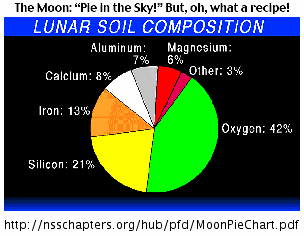






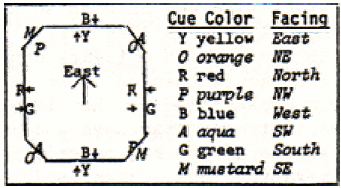




 [PK]
[PK]




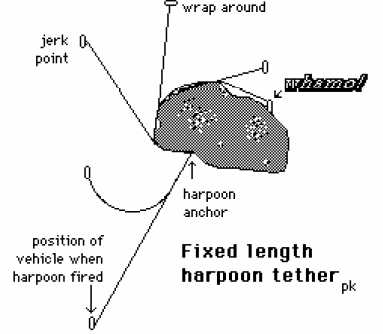





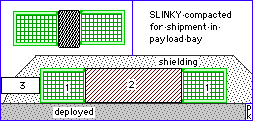

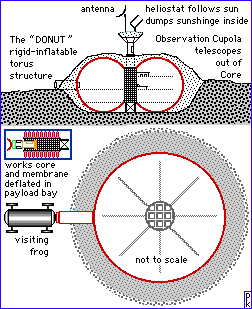



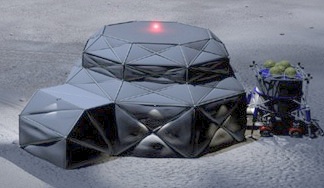






 Lunar Prospector Team
Mission Patch
-
Lunar Prospector Team
Mission Patch
- 
















